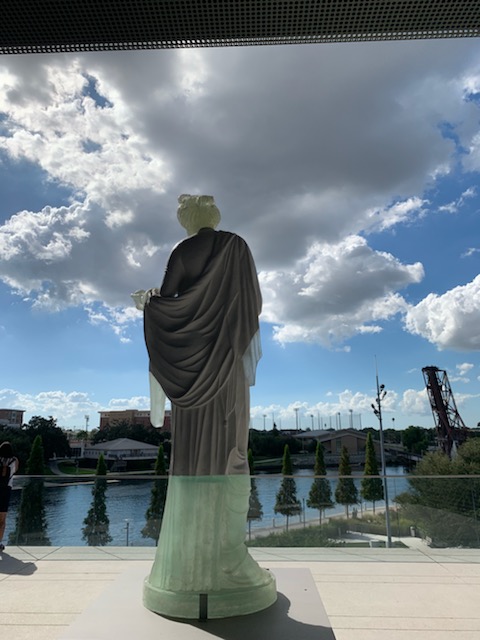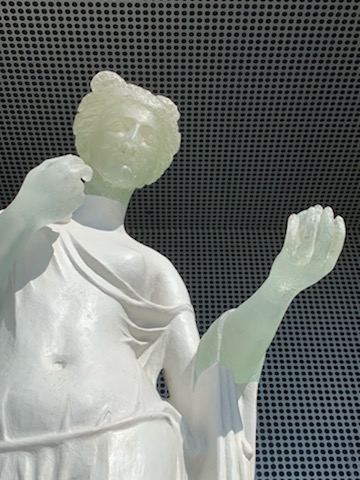
Installation view of the exhibition "Patricia Cronin, Aphrodite, and the Lure of Antiquity: Conversations with the Collection" at the Tampa Museum of Art. Photo: Eleanor Eichenbaum
Artist Patricia Cronin’s “Aphrodite and the Lure of Antiquity” is the inaugural exhibition in the Tampa Museum’s Conversations with the Collection, which puts contemporary art in dialogue with classical antiquities. The exhibit fills two large galleries and the outdoor terrace on the Museum’s second floor. Cronin, a widely recognized Brooklyn-based artist, offers a show that is thoughtful, feminist, materially dazzling, and asks dimensional questions of the fragment and the whole.
The exhibition features three main series of works, all of which engage materially and conceptually. The works feature tactile media; from stone to glass to blue painter’s tarps, to create a densely layered experience. The works echo with female multiplicity— the woman as artist, the woman as symbol, the woman as present, the woman as absent. Cronin interrogates what is missing – in the history of women, of women artists, and in physical reality. Sculptures may be partial, paintings may contain traces, negative space may be charged.
Walking through the exhibition, a viewer threads connections between thoughts and works. Seams – flickering lines of betweenness— are integral to the character of the show. Cronin’s works hinge on the possibility of questions made visible, of touching the ephemeral through noticing the absent.

Installation view of the exhibition "Patricia Cronin, Aphrodite, and the Lure of Antiquity: Conversations with the Collection" at the Tampa Museum of Art. Photo: Bay Art Files.
The gallery closest to the stairs, where the visitor arrives, features works from the Aphrodite Reimagined series. Cronin’s mastery of material choices resonates in this cool bluish room where the sculptural pieces converse with the layered works on the walls. Large paintings with gossamer transparencies depict outlines of individual Aphrodite sculptures from various museum collections. The paintings show the different presences of these particular Aphrodites; the form of the sculptural body is featured in relief, the background rendered as an aqueous field. Viewing these many traces of Aphrodites, a viewer may consider multiplicities in Aphrodite’s symbolic identities and in the histories of these sculptures. Cronin’s paintings are soft and illuminate the ineffable space between line and body. These works conjure what is ghostly, what is fluid— a seam of the permeable that runs through the show.
Of particular interest is Cronin’s Aphrodite (Metropolitan Museum): a two-part sculpture made of deep green cast glass displayed on a pedestal, its two halves set apart by a cushion of space. This piece is Cronin’s first work in cast glass and displays the sculptural body as impression. The seam, a site of joining to create a potential whole, is rendered visible here through the two halves that the viewer may work to visually assemble. In addition to its watery translucence, the apt material choice holds the moment the molten glass stills. This quiet interrogation of the momentary resonates in the exhibition.
Cronin’s moving Memorial to a Marriage and works that focus on the 19th-century American female sculptor Harriet Hosmer share the next large gallery. These works amplify questions of presence and absence. Memorial to a Marriage is functional as an iteration of memorial sculpture in Woodlawn Cemetery for Cronin and her wife, the artist Deborah Kass. They are depicted in marble, asleep and embracing under folds of sheets. The sculpture witnesses the connected lives of two female artists and holds both tenderness and contemplative melancholy. The creamy stone is perhaps the exhibition’s most taut moment of absence, as it materializes questions of mortality. Memorial to a Marriage was initially created in 2002 and predates the legalization of gay marriage by the United States Supreme Court by thirteen years. Another kind of booming absence – one of equality.
Through the project Harriet Hosmer: Lost and Found, A Catalogue Raisonne, Cronin illuminates Hosmer’s work and asks that the viewer see the artist’s works that have been lost to history. Cronin renders these lost works as watery shimmering outlines on paper and as towering abstractions on fabric – revealing each as a glance, a shadow, a ghost. The threads of what was lost are realized in two monumental wall-mounted silk pieces: Queen of Naples and Ghost. The fabric cascades far above the viewer’s height and the air in the gallery animate these pieces with slight billows. The works are both subtle and imposing, like an urgent but hazy memory or like blinking in a dark room trying to find her.
Installation view of the exhibition "Patricia Cronin, Aphrodite, and the Lure of Antiquity: Conversations with the Collection" at the Tampa Museum of Art. Photo: Bay Art Files
.Installation view of the exhibition "Patricia Cronin, Aphrodite, and the Lure of Antiquity: Conversations with the Collection" at the Tampa Museum of Art. Photo: Bay Art Files.
The her that the viewer ultimately finds is Cronin’s outdoor sculpture, Aphrodite Reimagined. She towers above the viewer and dialogues with light and landscape, her face towards the Hillsborough River. The piece, a whole composite Aphrodite, was inspired by a fragmentary 1st-century AD sculpture in the Museum’s classical antiquities collection. In fact, the viewer may encounter the ancient marble torso on display in the gallery, before proceeding to the terrace. This impression of the fragmentary flashes and is enforced in Cronin’s monumental, Aphrodite Reimagined. Strikingly, her legs, feet, arms, hands, and head are translucent resin, pale green and watery while the draped torso is gray and fixed in stone. Outside, these glassy hands catch light. Light slips through them – a prismatic recasting of stubborn histories. Hands, the means by which we count, gesture, touch, and hold are rendered physically anew from a material that mimics absence and calls attention to what we can now see.
Eleanor Eichenbaum is a writer and educator based in St. Petersburg, Florida. She is also an independent curator of visual arts and has organized exhibits in New York, New Jersey, and California.
Patricia Cronin, Aphrodite, and the Lure of Antiquity: Conversations with the Collection is on view at the Tampa Museum of Art through March 17, 2019.
For more information, visit the museum’s website at tampamuseum.org.

